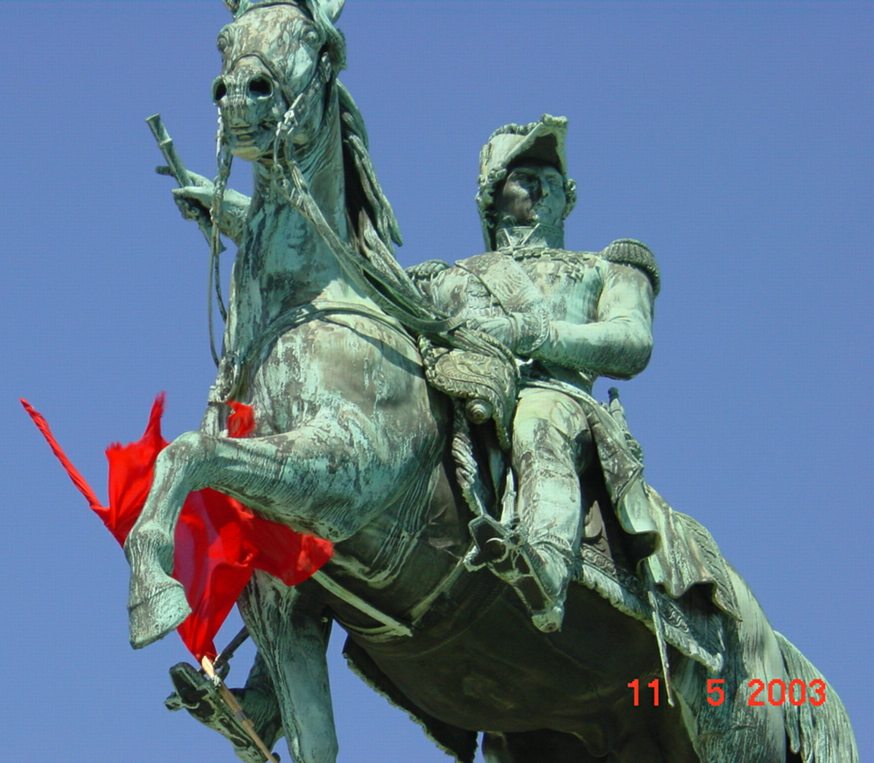
Catti Ejnar

Vi åkte ut med den nya båten, Söderarm, den 22 juli 2004. På Grinda åt vi gott och gladdes åt den vackra sommardagen.
Taliban
Afghanistan selbst ist ein islamischer
Vielvölkerstadt, der seit 22 Jahren vom Bürgerkrieg
zerrissen wird. Nach dem sowjetischen Einmarsch Ende 1979
kämpften moslemische Mudschahedin-Gruppen zehn Jahre
auch mit Hilfe der USA gegen die Militärmacht der UdSSR.
1992 stürzten sie die moskautreue Regierung. Vier Jahre
später gingen die radikal-islamischen Taliban-Milizen
aus dem anschliessenden Krieg der Freischärler
untereinander als Sieger hervor. Ûber ihr
militärisches Potenzial gibt es keine verlässlichen
Angaben.
84 Prozent der Einwohner sind sunnitische, 15 Prozent
schiitische Moslems. Die grösste
Bevölkerungsgruppe und Stütze des Regimes sind
Paschtunen mit 38 Prozent. Zu ihren Gegnern gehören die
Tadschiken, die in einer so genannten Nordallianz gegen die
Taliban kämpfen.
Ned karta Durandlinjen Herat mm
Afghanistan gehört zu den ärmsten Ländern der Welt
Das von den Taliban nach Eroberung der Hauptstadt Kabul 1996 zu etwa 90 Prozent kontrollierte Land am Hindukusch liegt wirtschaftlich am Boden. Die meisten Menschen hungern. Schuld daran sind nicht nur die kriegerischen Zerstörungen und die weltweite Isolation des "Islamischen Emirats Afghanistan". Auch Naturkatastrophen und das dritte Dürrejahr in Folge haben Afghanistan zu einem der ärmsten Länder der Welt gemacht. Nur Drogenanbau und -handel wird anscheinend noch betrieben, obwohl das Regime unter Taliban-Führer Mohammed Omar dies verboten hat. Dabei bieten reiche Vorkommen an Kupfer, Öl und Erdgas durchaus Perspektiven für eine wirtschaftliche Entwicklung.
Mit 650.000 Quadratkilometern ist Afghanistan fast zweimal so
gross wie Deutschland. Zwischen dem befreundeten
Pakistan im Osten und Süden, Iran im Westen und
früheren Sowjetrepubliken im Norden leben
schätzungsweise über 22 Millionen Menschen. Die
Bevölkerungszahl hat sich in den letzten Jahren
verringert, weil mehrere Millionen Afghanen, darunter fast
die gesamte Intelligenz, aus ihrer Heimat geflohen sind.
Källa: Der Spiegel
Last week, the bill came due on the U.S. decision, taken more than two decades ago, to arm and finance a fundamentalist jihad, or holy war, against the Soviet invasion of Afghanistan. The U.S. must now launch a war against the sophisticated and well-equipped terrorist network that it helped spawn.
A sense of what's ahead
Even before Soviet tanks rolled into Kabul in December 1979,
Brzezinski recognized the trouble-making potential of a few
well-armed religious zealots. During the summer of 1979, he
persuaded President Jimmy Carter to sign a secret directive
to supply covert aid to a budding mujahedeen movement.
What began as a trickle would soon turn into a flood of arms
and money. The CIA took responsibility for acquisition and
shipment of weapons. Much of the hardware was purchased on
the black market from Soviet bloc countries, although one of
the most effective weapons in the mujahedeen's arsenal
would turn out to be U.S.-made Stinger missiles. They used
the missiles to shoot down hundreds of Russian
helicopters.
Pakistan's Interservices Intelligence Directorate,
working closely with the CIA, was in charge of recruiting and
training the guerrillas.
The directorate cast a wide net. Religiously-inclined young
men from North Africa, the Persian Gulf region and
Palestinian refugee camps that fester across the Middle East
signed up for the jihad. One of the early recruits was a
young and very wealthy Saudi construction tycoon named Osama
bin Laden.
Money for the undertaking poured in from the anti-communist
Saudis.
The CIA's jihad, well under way within a year, was warmly
embraced by the Reagan administration when it took office in
1981. Afghanistan was becoming the Soviet
Union's Vietnam. Over the course of the next eight
years, the relentless hit-and-run tactics of the mujahedeen,
or holy warriors, would demoralize the Soviet Union and sap
the strength of its military.
Recruiters return home
When the Soviets gave up and pulled out in 1989, the
mujahedeen recruited from different Arab countries began to
trickle back to their homelands.
The end of the war coincided with a surging Islamic militancy
that had spread from Iran and Afghanistan to almost every
corner of the Muslim world. Veterans from the conflict saw
themselves as the vanguard of a new revolutionary
order.
The ruling establishment saw them as dangerous and
destabilizing elements.
Egypt spent the better part of the 1990s in a brutal
crackdown against an Islamic insurgency led by veterans from
the Afghan war. Among the horrors of this conflict was the
1997 massacre of 58 foreign tourists in Luxor.
In Algeria, more than 100,000 people have died in a war
between a corrupt government dominated by the military and an
Islamic movement led by Afghan war veterans.
The 1993 attack on the World Trade Center in New York, the
car bombs in Moscow linked to Chechen rebels, the kidnappings
of foreigners by the Abu Sayyaf rebel group in the
Philippines--all share a common Afghan pedigree.
Bin Laden returned to Saudi Arabia after the Soviets left
Afghanistan. There he focused his wrath on the monarchy,
which he viewed as decadent and too friendly to the United
States.
He was particularly incensed by the monarchy's
willingness to permit American troops to set up bases on
Saudi soil leading up to and during the 1991Persian Gulf
war.
Meanwhile, the Soviet pullout from Afghanistan turned this benighted
land into a chaotic battleground for warlords and
druglords.
Taliban services enlisted
Pakistan, already burdened by 2 million war refugees, sought
to impose some semblance of order by enlisting the services
of an obscure group of puritanical religious students known
as the Taliban, whose name means "students."
Lavishly funded by the equally puritanical Saudis; armed,
trained and organized by Pakistan's intelligence
directorate, the Taliban gradually took control of the
country.
Evidence of U.S. involvement at this point is sketchy. All
that can be said with certainty is that the Clinton
administration, failing to recognize the danger signs, did
nothing to curb Saudi or Pakistani support for the
Taliban.
At first the Taliban was welcomed by the Afghans. At least
the Taliban seemed honest, if perhaps a little over
zealous.
But soon the group's true intentions became clear--a
fanatically "pure" Islamic society that virtually
enslaves its women and insists that non-Muslims wear badges
that identify them as such.
Under the Taliban's harsh judicial code, apostates are
beheaded and "sodomizers" buried alive.
Bin Laden, finding himself under house arrest in Saudi
Arabia, fled the country in 1991. He went first to Afghanistan,
and then to Sudan, where an Islamic fundamentalist regime had
just come to power. There he set up legitimate businesses as
well as a few training camps for terrorists.
Bin Laden was forced to move again in 1996 after the U.S.
applied intense diplomatic pressure on Sudan. He went back to
Afghanistan, where the Taliban welcomed
him as an honored "guest."
Wealthy
supporters
Despite its pariah status in the international community, it
is believed that the Taliban movement is still heavily funded
by a network of wealthy Saudi businessmen, and Saudi Arabia
remains one of only three countries that recognizes the
Taliban government. The others are the United Arab Emirates
and Pakistan.
Pakistan's intelligence agency keeps close tabs on the
Taliban, though the government of Gen. Pervez Musharraf has
tried to distance itself from some of the more odious aspects
of the regime next door.
As the clamor mounts for retaliatory strikes against
Afghanistan, the Taliban government has warned its
neighbors--specifically Pakistan--that anyone who cooperates
with the U.S. will face a jihad, not a warning to be taken
lightly in this neighborhood.
Mullah Mohammed Omar, the reclusive leader of the Taliban,
has asked his followers to prepare themselves for a fight to
the death against the U.S. Taliban officials are reactivating
former fighters from across the country and Pakistan.
A new tidal wave of refugees is welling up. Iran already has
shut its border and Pakistan is trying to do the same.
Afghanistan is a hard and unforgiving
place. Britain, the superpower of the 19th Century, fought
and lost a long war in its barren mountains.
In the 20th Century, it was the Soviet Union that slowly bled
to death on its high plateaus.
President Bush has warned America that first war of the 21st
Century will not be quick or easy. If it is fought in
Afghanistan, there is no guarantee that it will be successful
either.
Källa © 2001, Chicago Tribune





